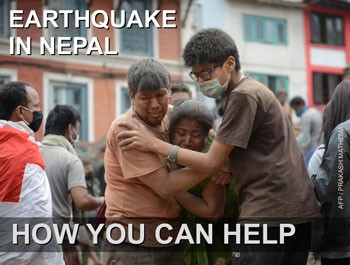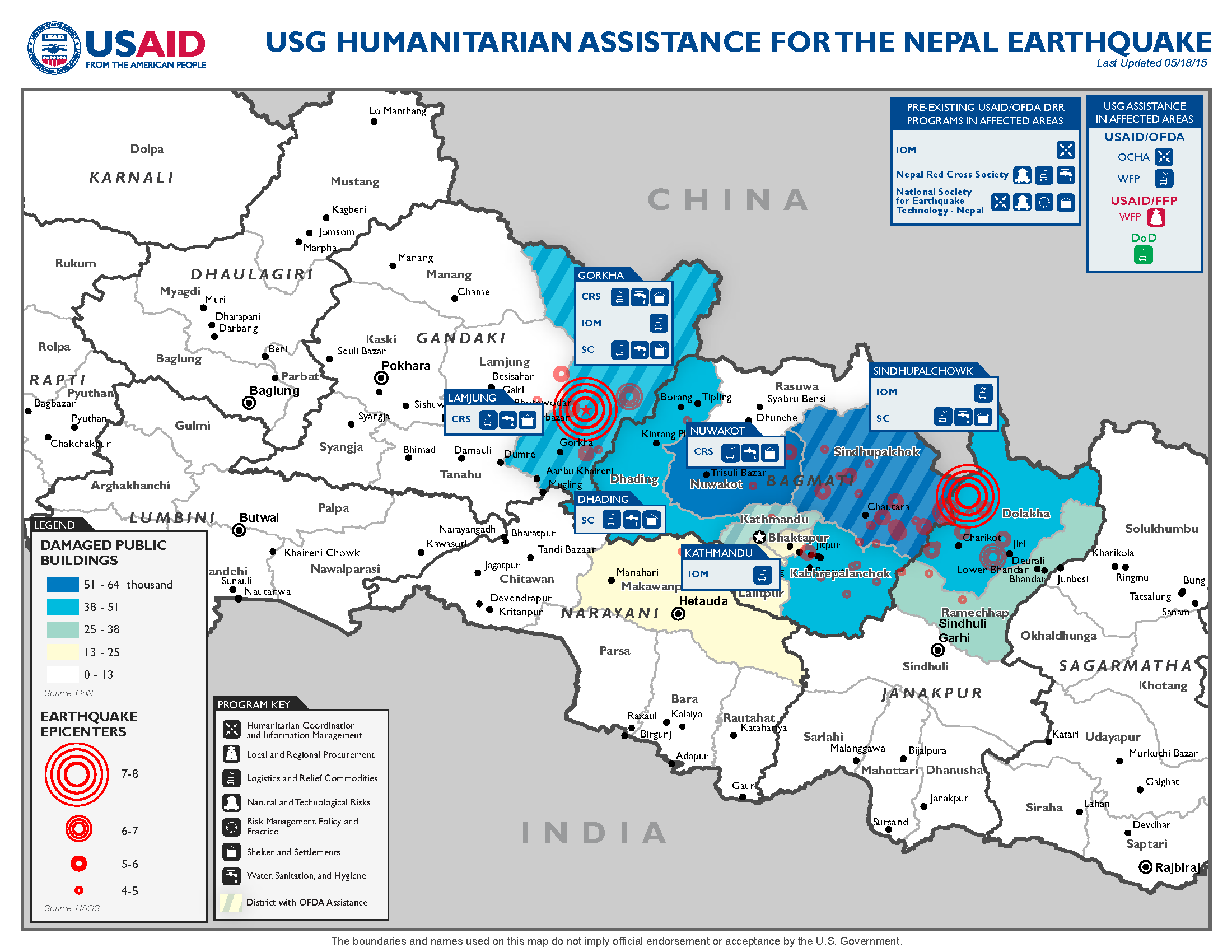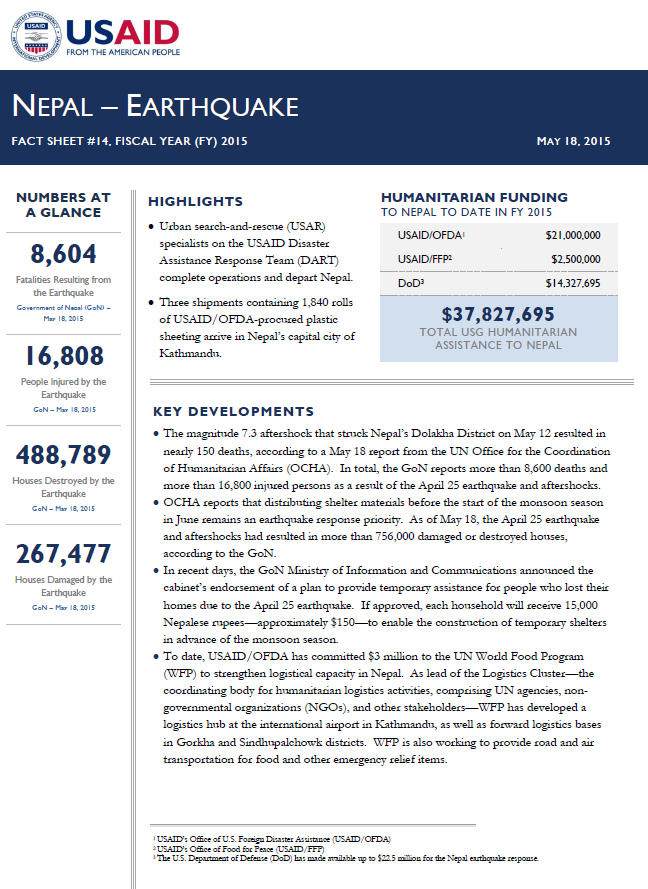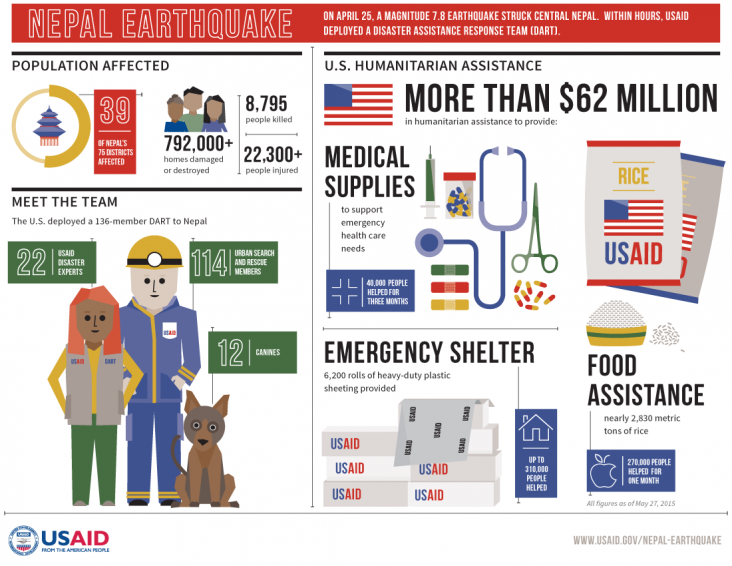Speeches Shim
May 18, 2015
Highlights
Urban search-and-rescue (USAR) specialists on the USAID Disaster Assistance Response Team (DART) complete operations and depart Nepal.
Three shipments containing 1,840 rolls of USAID/OFDA-procured plastic sheeting arrive in Nepal’s capital city of Kathmandu.
Key Developments
The magnitude 7.3 aftershock that struck Nepal’s Dolakha District on May 12 resulted in nearly 150 deaths, according to a May 18 report from the UN Office for the Coordination of Humanitarian Affairs (OCHA). In total, the GoN reports more than 8,600 deaths and more than 16,800 injured persons as a result of the April 25 earthquake and aftershocks.
Nepal Earthquake Map - May 18, 2015 ![]() (pdf - 994k)
(pdf - 994k)
Numbers At A Glance
8,604
16,808
488,789
267,477
Humanitarian Funding:
To Nepal To Date In FY2015:
| USAID/OFDA | $21,000,000 |
| USAID/FFP | $2,500,000 |
| DoD | $14,327,695 |
| TOTAL | $37,827,695 |
Nepal Earthquake Fact Sheet #14 - 05-18-2015 ![]() (pdf - 180k)
(pdf - 180k)
OCHA reports that distributing shelter materials before the start of the monsoon season in June remains an earthquake response priority. As of May 18, the April 25 earthquake and aftershocks had resulted in more than 756,000 damaged or destroyed houses, according to the GoN.
In recent days, the GoN Ministry of Information and Communications announced the cabinet’s endorsement of a plan to provide temporary assistance for people who lost their homes due to the April 25 earthquake. If approved, each household will receive 15,000 Nepalese rupees—approximately $150—to enable the construction of temporary shelters in advance of the monsoon season.
To date, USAID/OFDA has committed $3 million to the UN World Food Program (WFP) to strengthen logistical capacity in Nepal. As lead of the Logistics Cluster—the coordinating body for humanitarian logistics activities, comprising UN agencies, non-governmental organizations (NGOs), and other stakeholders—WFP has developed a logistics hub at the international airport in Kathmandu, as well as forward logistics bases in Gorkha and Sindhupalchowk districts. WFP is also working to provide road and air transportation for food and other emergency relief items.
USAR AND LOGISTICS
After assisting with search-and-rescue operations and conducting structural assessments following the May 12 aftershock, DART USAR personnel began departing Nepal on May 14. By May 17, all 114 USAR specialists and 12 canines deployed to Nepal from the Fairfax County Fire and Rescue Department and the Los Angeles County Fire Department had safely returned to the U.S.
While in Nepal, the USAR teams conducted two live rescues, covered a search area of more than 15 square miles, and provided medical care to people injured by the May 12 aftershock. In addition, the teams’ structural engineers surveyed approximately 130 buildings and bridges for earthquake damage, including the ancient Hindu Changu Narayan Temple—a UNESCO World Heritage Site.
Following the completion of their mission, the USAR teams donated search-and-rescue equipment and supplies brought for the earthquake response to the Nepal Ambulance Service. The items, including medical supplies, light rescue equipment, and other response resources, will help the Nepal Ambulance Service respond to future crises.
As of May 17, the U.S. military had airlifted more than 109 tons of relief supplies, including plastic sheeting, shelter kits, blankets, food, water, and medical supplies, to support the earthquake response in Nepal. U.S military assets deployed to Nepal in support of the relief mission have included U.S. Marine Corps UH-1Y Huey helicopters, MV-22B Ospreys, KC-130J Hercules, and U.S. Air Force C-130H and C-17 Globemaster III aircraft, as well as various ground and aviation command and control assets. The U.S. Air Force’s 36th Contingency Response Group has been working in Kathmandu with the DART, the GoN, and WFP to streamline airfield operations and expedite the distribution of relief supplies to communities in need.
To date, USAID/OFDA has provided more than $6 million to provide logistics support and relief commodities to respond to the April 25 earthquake and aftershocks in Nepal. In addition to WFP, USAID/OFDA is supporting the International Organization for Migration (IOM), Catholic Relief Services (CRS), and Save the Children (SC) to provide relief commodities to populations in districts that experienced the most severe earthquake effects.
HUMANITARIAN ASSESSMENTS
During the week of May 11, DART staff conducted field assessments in Dhading, Dolakha, Gorkha, Lamjung, Nuwakot, and Sindhupalchowk districts. The assessments, limited to road-accessible areas near district centers, found that districts closer to the April 25 earthquake epicenter, such as Dhading, Gorkha, and Lamjung, experienced less damage. Additionally, DART staff observed that populations in rural areas had begun recovery activities, including salvaging materials and constructing semi-permanent shelters. Recovery activities in urban areas are more complex; demolition and debris removal of damaged and destroyed buildings is challenging and will likely require technical assistance. Similarly, although the earthquake and resulting landslides have damaged some agricultural lands, many people in rural areas may be able to continue agricultural practices, while recovery of livelihoods in urban areas may require additional interventions.
The Kathmandu-based International Center for Integrated Mountain Development (ICIMOD)—a regional inter-governmental learning and knowledge sharing center that USAID/OFDA supported between 2006 and 2012—is mapping and assessing hazards created by landslides, rock falls, and avalanches in the aftermath of the April 25 earthquake and ensuing aftershocks. The ICIMOD task force on geohazards visited the Langtang region in northeastern Rasuwa District on May 12 to assess geohazards in the area and assess the conditions of ICIMOD’s Langtang research station. While ICIMOD’s research station was substantially damaged, the task force continues to work with the U.S. National Aeronautics and Space Administration (NASA) to assess landslides and river blockages in earthquake-affected areas. ICIMOD staff report that the eight highest villages in Langtang—a popular trekking area— were severely damaged or completely destroyed by landslides and avalanches in the aftermath of the earthquakes.
On May 14, the USAID/OFDA Geographic Information Unit provided ICIMOD with more than 100 gigabytes of satellite imagery to assist the organization with performing analysis on the effects of the April 25 earthquake.
DISPLACEMENT AND SHELTER
Following the May 12 aftershock, USAID/OFDA partner IOM conducted a rapid assessment of pre-identified open spaces for humanitarian activities in the Kathmandu Valley. Fluid population movement in the open spaces continues, and IOM observed some households preparing emergency shelters. IOM is finalizing assessments of 11 earthquake-affected districts outside of Kathmandu Valley and plans to launch a second round of the Displacement Tracking Matrix, which will include additional information on the pre-identified open spaces, in the coming days.
NGOs are prioritizing the delivery of shelter and other emergency relief items to remote and inaccessible areas of affected districts prior to monsoon season, the DART reports. NGOs are utilizing a variety of creative methods to access remote areas, such as establishing forward logistics bases, conducting deliveries by helicopter, using mountaineers to establish new supply routes, and forging agreements with porters to deliver supplies and provide labor for shelter construction.
On May 16 and 17, three shipments containing 1,840 rolls of USAID/OFDA-procured plastic sheeting arrived at the airport in Kathmandu. USAID/OFDA has consigned the plastic sheeting to IOM for onward distribution through various partner agencies. To date, USAID/OFDA has airlifted 4,360 rolls of plastic sheeting to provide temporary shelter assistance for up to 218,000 earthquake-affected people.
USAID/OFDA has also committed nearly $549,000 to support additional shelter interventions. SC is targeting 7,050 earthquake-affected households—approximately 35,250 people—in Dhading and Gorkha districts with plastic sheeting and other shelter materials. CRS plans to deliver emergency shelter kits to 5,275 families—approximately 26,375 people—in Gorkha, Lamjung, and Nuwako districts. CRS is also providing cash vouchers to affected households to support transportation of shelter materials.
GON RESPONSE AND INTERNATIONAL ASSISTANCE
GoN Prime Minister Sushil Koirala appealed for $2 billion in international assistance on May 17 toward a national rehabilitation and reconstruction fund to support rebuilding and economic recovery efforts, international media reports. The GoN has allotted $200 million toward the fund and is advocating for additional support from international donors and the private sector.
As of May 18, international donors had contributed nearly $216 million for the Nepal earthquake response, including more than $72 million—17 percent—toward the $423 million flash appeal. The USG remains the largest international donor for earthquake response and recovery efforts in Nepal, with nearly $38 million provided to date.
CONTEXT
On April 25, a magnitude 7.8 earthquake struck central Nepal’s Gorkha District, approximately 77 kilometers (km) northwest of Kathmandu, at a depth of approximately 15 km, according to the U.S. Geological Survey (USGS).
The USG immediately issued a disaster declaration for Nepal due to the effects of the earthquake. Within hours of the seismic event, USAID/OFDA activated a Response Management Team (RMT) in Washington, D.C., and deployed a DART—including urban search-and-rescue specialists—to support emergency response efforts in Nepal.
On May 12, a magnitude 7.3 aftershock struck Nepal’s Dolakha District, approximately 76 km northeast of Kathmandu, according to USGS. The aftershock caused further casualties and damages in areas affected by the April 25 earthquake.
For nearly two decades, USAID/OFDA has supported disaster risk reduction (DRR) efforts in Nepal, including throughout Kathmandu Valley. USAID/OFDA funding has enabled partners to identify, prepare, and preserve more than 80 open spaces in Kathmandu Valley for humanitarian purposes; pre-position critical emergency relief supplies; and strengthen earthquake response capacity at the local and national levels in collaboration with the GoN, non-governmental organizations, private companies, and local communities. More information on USAID/OFDA’s DRR programs in Nepal and throughout South Asia is available at www.usaid.gov/what-we-do/working-crises-and-conflict/disaster-risk-reduc....
PUBLIC DONATION INFORMATION
The most effective way people can assist relief efforts is by making cash contributions to humanitarian organizations that are conducting relief operations. A list of humanitarian organizations that are accepting cash donations for disaster responses around the world can be found at www.interaction.org.
USAID encourages cash donations because they allow aid professionals to procure the exact items needed (often in the affected region); reduce the burden on scarce resources (such as transportation routes, staff time, and warehouse space); can be transferred very quickly and without transportation costs; support the economy of the disaster-stricken region; and ensure culturally, dietary, and environmentally appropriate assistance.
More information can be found at:
- The Center for International Disaster Information: www.cidi.org or +1.202.821.1999.
-
Information on relief activities of the humanitarian community can be found at www.reliefweb.int.





Comment
Make a general inquiry or suggest an improvement.